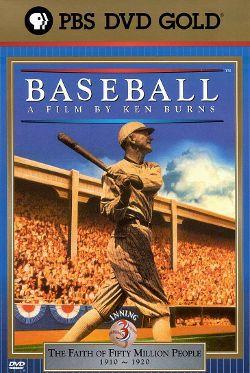
The Third Inning of Baseball: A Film By Ken Burns explores the game during the 1910s. This disc opens with a discussion of fan involvement, and how the setup of the field during this time period gave fans a greater amount of influence in the events of the game. Fans often spectated standing in foul territory or directly on the field behind the outfielders, allowing them not only to yell at players more effectively, but also to potentially become physically involved in some plays. And it wasn’t just fans rooting for their teams who sought to influence the outcome of games. Gamblers during this time period were heavily involved in the sport.
Connie Mack’s Philadelphia Athletics dominated the first half of the decade. Meanwhile, the saga of Ty Cobb continues, from his 1910 race for the batting title against Nap Lajoie to Cobb’s suspension from organized baseball for beating the snot out of a fan in 1912.
Buck O’Neil, who has contributed to the commentary of the documentary series in the first two innings, was born in 1911, and now discusses his experience with baseball as a boy. Baseball’s “gentleman’s agreement,” however, continued to exclude black players from the game, though teams at times undermined this agreement with light-skinned minority players.
The 1912 World Series between the Boston Red Sox and the New York Giants became an unusual eight-game Series when the second game was called due to “impending darkness.” Game eight of this Series was the one in which Fred Snodgrass dropped an easy fly ball, which allowed hitter Red Sox Clyde Engle to make it all the way to second. Engle would later score, tying the game at 2-2, and Red Sox went on to first load the bases, then score the winning run. Poor Snodgrass joined the ranks of dubious fame with Fred Merkle as a result.
The clouds of scandal appear early with the figure of Hal Chase. His willingness to throw games was so well-known that even fans took to chanting, “What’s the odds,” whenever Chase took the field. Players throughout baseball expressed their own discontent with the reserve clause and the complete control of owners over their contracts. The formation of the Federal League attempted to address this discontent in promising players the opportunity for free agency. The new league only lasted two seasons, however, and the players found themselves still without a voice.
On this disc, we meet pitcher Grover Cleveland Alexander, and we see more of the progression of Branch Rickey’s baseball career. The 1916 World Series went to the Boston Red Sox over the Brooklyn Superbas. The 1917 Series went to the Chicago White Sox over the New York Giants, then Boston returned to win the 1918 Series, this time over the Cubs. When World War I broke out, Major League Baseball as a whole seemingly turned a blind eye. Some players did serve during the war, including Grover Alexander, Ty Cobb, and Christy Mathewson, and Branch Rickey joined the effort as well.
The last half hour of the Third Inning went into detail covering the 1919 Black Sox scandal. I particularly found it fascinating that Burns managed to find a Chicago fan who had been fifteen years old at the time of the scandal. This fan recalled his disbelief that the White Sox had managed to lose the Series, being too young to understand the world of gambling at the time. His shock and disappointment no doubt reflected the feeling of baseball fans everywhere at the time. Though as Buck O’Neil describes at the very end of this disc, while the scandal turned a lot of folks away from the game at the time, it wouldn’t be long before a new hero would draw them back — a man named Babe Ruth.




